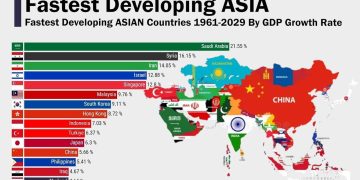I. The Core Question: What Happens When Money Itself Becomes Infrastructure?
For nearly half a century, global payments evolved like plumbing—quietly, invisibly, and predictably. The average consumer never wondered how cross-border transfers settled, how correspondent banks reconciled accounts, or how clearing networks synchronized across currencies. Payments were the “background layer” of globalization, a system that functioned well enough and changed slowly.
But over the past decade, money is no longer just a medium of exchange—it has become infrastructure, software, and increasingly a geopolitical asset. Payment rails once controlled by banks are now being rewritten by:
- Big Tech platforms
- Instant-payment networks
- Digital wallets with hundreds of millions of users
- Central banks developing programmable digital currencies
- Geopolitical blocs building their own settlement systems
- Fintechs creating new messaging, identity, and verification layers
The world has reached an inflection point. The fundamental question is no longer who moves money, but which infrastructure will define the next 30 years of global financial connectivity.
We are entering an era where payments are fragmented, programmable, competitive, and strategic—and the consequences will reshape global finance more deeply than the internet reshaped communication.
II. The Forces Pushing Transformation: Technology, Consumer Behavior, and Liquidity Pressure
1. The Decline of Traditional Correspondent Banking
Correspondent banking once dominated cross-border money movement. But its efficiency is increasingly questioned:
- Slow settlement times
- High fees across intermediary hops
- Fragmentation of liquidity pools
- Growing compliance and AML costs
- Limited transparency in the payment path
From 2011 to 2024, the number of global correspondent banking relationships dropped by nearly 20%. This is not a cyclical correction—it is structural. Banks increasingly cannot hold correspondent accounts in every region while meeting regulatory requirements and capital constraints.
2. Real-Time Domestic Payments Creating Global Expectations
Consumers accustomed to instant messaging now expect instant money. Domestic real-time payment systems—UPI in India, Pix in Brazil, FedNow in the United States, and Faster Payments in the UK—have created a psychological shift:
If money can move instantly within borders, why can’t it move instantly across them?
This expectation fuels demand for real-time, transparent, low-cost global transfers—something legacy systems were never built to provide.
3. Fintechs Redefining “Payment Experience”
Fintechs such as Stripe, Revolut, Wise, PayPal, M-Pesa, and Alipay treat payments as:
- An API
- A product
- A business model
- A consumer experience
They offer:
- Real-time FX rates
- Transparent fees
- Integrated compliance
- Embedded payments in apps, logistics, marketplaces
- Seamless onboarding for SMEs
Fintechs are not replacing banks—they are replacing friction.
4. Liquidity Constraints and the New Cost of Capital
Higher global interest rates have reshaped payment economics. Capital is no longer cheap. Maintaining global nostro/vostro liquidity pools is expensive. Banks must optimize balance sheets, and real-time settlement reduces the need for capital-intensive pre-funding.
This liquidity pressure accelerates the shift toward systems that settle faster, require less float, and automate risk management.
III. The Forces Resisting or Redirecting Change: Regulation, Sovereignty, and Interoperability Limits
Even as technology accelerates, the friction in payments has changed form rather than disappeared.
1. Regulatory Fragmentation
Every government now sees payments as:
- A national security issue
- A sovereignty issue
- A data governance issue
- A capital control tool
- A consumer protection domain
This creates conflicting regulatory landscapes:
- PSD3 vs. U.S. state-level money transmission licenses
- China’s data localization laws vs. EU GDPR
- Basel AML requirements vs. domestic fintech licensing regimes
- Restrictions on stablecoin issuance across jurisdictions
Innovation moves fast, but regulation moves by consensus—often years behind.
2. Interoperability: The Hardest Problem in Payments
Payments rely on:
- Identity
- Messaging
- Authorization
- Settlement
- FX
- Compliance
Different systems solve these steps differently. Real-time systems often cannot “talk” to each other. A payment that is instant in one country still must pass through layers of messaging, risk checks, and compliance before reaching another.
Interoperability is not just technical—it is political.
3. Banks Preserving Their Role
Banks still control:
- Settlement accounts
- KYC infrastructure
- Access to central-bank rails
- Large corporate treasury services
- Global trade finance networks
They resist models that disintermediate them and emphasize their stability, compliance capability, and risk management expertise.
This tension between incumbents and innovators is reshaping the competitive landscape.
IV. Future Scenarios: Four Possible Worlds for Global Payments (2025–2035)
Scenario 1: A Multipolar Payment System Dominated by Regional Blocks
In this world:
- Asia builds integrated CIPS-UPI-Asean networks
- Europe strengthens SEPA and its digital euro infrastructure
- U.S. dollar networks converge around FedNow, CHIPS, and private sector rails
- Africa accelerates mobile-money interoperability
Global payments become regional, not global.
Cross-border transactions route through geopolitical alliances.
Implication:
FX fragmentation, regional liquidity pools, and geopolitical constraints on capital mobility.
Scenario 2: Big Tech Becomes the Global Payments Layer
Imagine a world where cross-border payments run primarily through:
- Apple Pay
- Alipay+ network
- Google Wallet
- Meta’s payment infrastructure
- Amazon’s merchant settlement rails
Big Tech already connects billions of users and millions of merchants. Payments could become a platform feature, not a financial service.
Implication:
Banks lose consumer-facing relevance; data centralization raises regulatory battles.
Scenario 3: Digital Currencies Rewrite Settlement Itself
A world where:
- CBDCs become interoperable
- Wholesale digital currencies replace correspondent banking
- Stablecoins become institutional-grade settlement assets
- Programmable payments automate trade flows and escrow functions
Settlement becomes:
- Real-time
- Atomic
- Transparent
- Borderless
Implication:
FX markets become more efficient, liquidity costs fall, compliance becomes embedded in programmable rules.
Scenario 4: A Hybrid World—The Most Likely Path
The most probable outcome is a hybrid landscape with:
- Big Tech controlling front-end consumer interfaces
- Banks controlling liquidity and regulated settlement
- CBDCs providing interbank rails
- Stablecoins filling gaps in cross-border commerce
- Regional systems offering cheaper and faster routing options
Money becomes a layered system, where users do not notice which rail is used—only that payments are instant, cheap, and trustworthy.
V. What This Means for Global Finance: Five Strategic Shifts
1. Treasury Management Becomes Real-Time
Corporate treasurers will shift from:
- Daily batch reconciliation
to - Continuous liquidity optimization
Real-time FX, automated hedging, and AI-driven cash positioning become standard.
2. FX Markets Fragment but Become More Efficient
More currencies will be settled:
- On-chain
- Via regional networks
- Through stablecoin pairs
- Using automated market makers
The result:
FX spreads shrink, but complexity increases.
3. Compliance Moves from Manual to Embedded
Instead of post-transaction checks, compliance will be:
- Real-time
- Code-based
- Automated
- Integrated into smart contracts
This reduces fraud and de-risks global flows.
4. SMEs Become Global by Default
For the first time, small businesses will have:
- Instant cross-border payouts
- Multi-currency accounts
- Borderless compliance onboarding
- Embedded finance via SaaS platforms
Global trade becomes democratized.
5. Payments Become the Backbone of Digital Trade
As digital goods, creator commerce, AI services, cloud subscriptions, and micro-transactions grow, global payments must support:
- High frequency
- Low cost
- Automation
- Trust
Payments become the infrastructure of digital globalization.
VI. Conclusion: A Fragmented Frontier, but a More Dynamic One
We are entering a decade where no single system will dominate international payments. Instead, the landscape will be:
- Multipolar
- Competitive
- Interoperable
- Software-driven
- Real-time
- Politicized
- Consumer-centric
The biggest shift is philosophical:
Money is no longer a product of banks—it is a distributed network service.
The nations and institutions that succeed will not be the ones with the largest banks, but the ones who can build the most secure, most open, and most interoperable financial infrastructure.
Global payments are no longer plumbing.
They are the new architecture of international power.

































